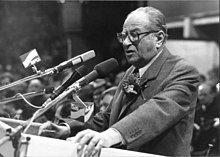National Council election in Austria 1983
The National Council election on April 24, 1983 was the 16th National Council election in the history of Austria . The strongest party was the SPÖ of Federal Chancellor Bruno Kreisky , which lost votes and mandates as well as its absolute majority after 12 years. With slight gains votes and mandate the occupied ÖVP of Alois Mock second place. The FPÖ , which ran with Norbert Steger as the top candidate, lost votes, but won an additional mandate. Neither the United Greens of Austria nor the Alternative List Austria achieved a basic mandate when they first appeared.
5,316,436 people were eligible to vote. The turnout was 91.29 percent (1971: 91.18).
background
Kreisky's fourth term turned out to be difficult. The Chancellor's health deteriorated steadily, which meant that he had to go on dialysis several times a week during the election campaign .
The political career of the charismatic and then only 42-year-old Finance Minister and Vice Chancellor Hannes Androsch , who was originally regarded as Kreisky's successor, failed towards the end of 1980 due to private business that was seen as incompatible with his state office.
The ruling SPÖ had put the ruling SPÖ under severe pressure, with excessive costs and bribes in the construction of the general hospital ( AKH scandal ). In addition, the construction of a conference center (see Austria Center Vienna ) was implemented despite massive resistance from the population. A referendum initiated by the ÖVP MPs was directed against the project and, with 1,361,562 signatures, was the most successful of the Second Republic ( list of referendums in Austria ).
The successful protest movement against the Zwentendorf nuclear power plant , which was built but never put into operation, gave rise to two green parties that competed against each other in the National Council election in 1983. While the ALÖ positioned itself on the left , conservative parts of the ecological movement came together at the VGÖ .
The Freedom Party went under its 1980 elected as chairman centrist economic liberals Norbert Steger , the worst result of party history and managed the re-entry into the parliament only the narrowest of margins.
The VGÖ failed not least because of a media campaign against their top candidate, the actor Herbert Fux . This was sexually denigrated by means of an interview in the magazine Basta published by Wolfgang Fellner . It was later determined by the court that the content of the interview was distorted and partly fictitious, but the damage to Fux's image was enormous and led to his replacement as the VGÖ top candidate.
Bottom line
| Candidates | be right | proportion of | Mandates | ||
|---|---|---|---|---|---|
| 1983 | ± | 1983 | ± | ||
| Socialist Party of Austria (SPÖ) | 2,312,529 | 47.6% | −3.4% | 90 | −5 |
| Austrian People's Party (ÖVP) | 2,097,808 | 43.2% | +1.3% | 81 | +4 |
| Freedom Party of Austria (FPÖ) | 241,789 | 5.0% | −1.1% | 12 | +1 |
| United Greens Austria - Tollmann List (VGÖ) | 93,798 | 2.0% | nk | 0 | - |
| Alternative list of Austria (ALÖ) | 65,816 | 1.4% | nk | 0 | - |
| Communist Party of Austria (KPÖ) | 31,912 | 0.66% | −0.30% | 0 | ± 0 |
| Austria Party (ÖP) | 5,851 | 0.1% | nk | 0 | - |
| Foreigner Halt Movement (AUS) | 3,914 | 0.0% | nk | 0 | - |
nk = not running
Results in the federal states
The results in the federal states are listed here.
| Political party | B. | K | N | O | S. | St. | T | V | W. |
|---|---|---|---|---|---|---|---|---|---|
| SPÖ | 51.4 | 52.9 | 45.9 | 46.3 | 41.3 | 49.4 | 34.8 | 27.3 | 56.6 |
| ÖVP | 44.3 | 32.1 | 48.1 | 43.5 | 46.1 | 42.3 | 57.4 | 60.3 | 33.6 |
| FPÖ | 2.2 | 10.7 | 3.0 | 6.0 | 8.0 | 3.97 | 4.4 | 7.2 | 4.4 |
| VGÖ | 0.99 | 2.0 | 1.5 | 2.3 | 2.7 | 1.5 | 1.5 | 2.7 | 2.3 |
| ALOE | 0.9 | 1.5 | 0.9 | 1.4 | 1.5 | 1.8 | 1.2 | 2.0 | 1.4 |
| KPÖ | 0.3 | 0.7 | 0.6 | 0.5 | 0.4 | 0.8 | 0.4 | 0.5 | 0.98 |
| PP | 0.2 | 0.3 | 0.35 | ||||||
| OUT | 0.40 |
consequences
After losing the absolute majority, Chancellor Bruno Kreisky, who was already very ill at the time, resigned. A government coalition between the SPÖ and the FPÖ was formed. The new Federal Chancellor was Fred Sinowatz , who had been Federal Minister for Education and the Arts since 1971 and Vice Chancellor since 1981. FPÖ chairman Norbert Steger became vice chancellor and trade minister . The Federal Government of Sinowatz began its work on May 24, 1983. The federal government Vranitzky I was in office from June 16, 1986 until the next election to the National Council .
Individual evidence
- ↑ Der Spiegel 48/1983: Herbert Fux
- ↑ Robert Kriechbaumer: Turn of the times: The SPÖ-FPÖ coalition 1983 - 1987. Böhlau Verlag Wien-Köln-Weimar 2008 ISBN 978-3-205-77770-0 p. 246f.
- ↑ Results by federal state



